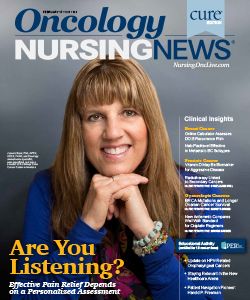Are You Listening?: Effective Pain Relief Depends on a Personalized Assessment
Cancer-related pain is among the most common and difficult symptoms patients confront. Assessing and managing it is also challenging for healthcare practitioners, but asking patients the right questions can help.
Jeannine Brant, PhD, APRN, AOCN, FAAN

Jeannine Brant, PhD, APRN, AOCN, FAAN
With all of the stress and symptoms that come with a cancer diagnosis, unrelieved pain should not be one of them. Asking patients to “rate their pain” on a 1 to 10 scale is now standard practice, but experts say these assessments need to be much more nuanced and individualized to offer patients real relief.
This means not only sitting down with patients for an interview and asking the right questions, but also understanding that other underlying complaints like depression and anxiety go hand-in-hand with hard-to-manage pain, and relieving one may go a long way in alleviating the other.
“We know that pain is a significant problem for patients with cancer and happens throughout the cancer trajectory,” said Jeannine Brant, PhD, APRN, AOCN, FAAN, an oncology clinical nurse specialist, pain consultant, and nurse scientist at the Billings Clinic Cancer Center in Montana.
In an interview with Oncology Nursing News® and during her presentation at the recent 34th Annual CFS™ (Chemotherapy Foundation Symposium™), Brant stressed the critical importance of conducting a full pain assessment rooted squarely in the patient’s experience.
“One of the challenges in pain management is that nobody owns it. The physicians are very busy, they’re diagnosing and treating the cancer and ordering chemotherapy and looking for complications.” But the good news is, nurses have stepped into that breach and are well-positioned to do so even more.
“Both nurses at the bedside and advanced practitioners are taking on greater roles in clinics, providing palliative care, and staying focused on the human response to illness, such as pain, anxiety, sleep disturbance, and fatigue. It’s all of those symptoms that can really cluster together and affect the patient quality of life.
“This is the nurse’s primary responsibility. We can work collaboratively as a team, with physicians, to really try to solve patients’ pain problems.”
“We need to focus on patients, address their fears, and encourage them to talk openly, stressing that this is a therapeutic alliance.”
The Therapeutic Alliance
“The pain assessment is the best thing we can do to help patients to manage their pain,” said Brant, and the patient interview is the most important part of the process. She recommends that nurses work to establish a therapeutic relationship and “really focus on our own nonverbal behaviors as well as the patient’s.”
The heightened attention on curbing opioid abuse in the United States, including the FDA’s move last summer to require stronger boxed warnings on prescription opioid analgesics, means nurses have to sometimes perform a balancing act: one that is attuned to behaviors suggesting substance abuse, while still providing patients in pain access to effective and appropriate pain management.
“We have to remember that patients with cancer are different than patients with chronic, nonmalignant pain,” Brant stressed. “Preventing that pain is important to their quality of life. These patients will use opioids, and they may use them at high doses. On the other hand, we do have patients with substance use disorders.”
Nonetheless, “if we start out in a judgmental fashion, the patient is already going to be protecting themselves … we need to focus on patients, address their fears, and encourage them to talk openly, stressing that this is a therapeutic alliance.” Carefully and compassionately listening to patients and keeping an eye out for high-risk or aberrant behaviors like losing a prescription or asking for an early refill that might signal a substance abuse disorder, will go a long way in this effort.
The latter, “Aberrant behavior,” is part of the 4-part process Brant recommends to help guide the pain assessment. When a quick pain assessment is needed, nurses want to know the location(s) of the pain, and the syndrome or pathway (eg, pins and needles or a dull, somatic pain), as well as its intensity on the 0 to 10 scale. She explained that the number itself is not the central focus: “What we want to do is use that score to assess the effectiveness of our interventions. If, for example, the pain score is an 8, and we employ a set of interventions, did we get a pain score now of 4?”
Another of the “A’s” of pain assessment, “activities,” Brant said, focuses on whether the interventions providers prescribe actually work. “Is the patient better because of what we’re doing? When we look at chronic pain management in cancer survivors, for example, we want to make sure that if we’re prescribing opioids or other adjuvants, that they’re actually moving, they’re improving, they’re functioning better than they did before.”
A variety of pain syndromes exist in oncology practice, stemming not only from the cancer itself, but also the methods used to treat it. Skilled practitioners can assess the patient, identify the pain syndrome, and then decide on the best approach. Actively engaging patients in their pain management can go a long way, said Brant.
“I definitely have patients who will say 'You know what, I'm getting too sleepy, I don't want to take the medication.' So then we try to find ways to decrease the sedative effects of opioids and other modalities.”
Patient education is essential in this collaborative relationship, she added. Nurses should explain to patients how different medications work (eg, long-acting versus breakthrough), and why they are used. “If nurses really partner with patients in developing the pain management plan, Brant added, that will help us to be more successful.”
Assessing Cancer Pain: The 4 A’s
- Analgesia How is the patient responding to current pain relief approaches?
- Activities Is the patient functional and better able to perform activities of daily living as a result of the pain relief provided?
- Adverse events Is their pain treatment causing any side effects or adverse events?
- Aberrant behaviors Do you observe any behaviors (eg, early Rx refills, losing a prescription) that may signal a substance abuse disorder?
Getting to the Root of the Problem
Assessing and managing cancer-related pain requires a team effort and a multimodal approach. The roots of patient pain are varied and complex, involving physical processes and psychological components. Although pharmacologic approaches are a critical part of the pain management tool kit, Brant said that it is important to be aware of any underlying psychological issues that may be in play.
“We know that people’s perception of pain and even their psychological and emotional well-being has a lot to do with how they perceive pain.” Brant’s current research is exploring possible links between adverse childhood experiences (ACEs) and how a patient copes with pain. These ACEs may cause in some people, “maladaptive coping or a lack of coping strategies that may lead to worse pain,” she explained.
Those traumatic experiences early in life can affect how patients cope and deal with pain and also their resilience level, she continued. “We really want to look at where that patient is coming from. Do they have a history of depression or anxiety? Do they have a family history of substance use disorder?
“We know that depression and anxiety coexist with pain. A lot of times if we manage the pain, it can help manage the depression and anxiety, and vice versa.” Although this can be done pharmacologically, she added that counseling, sitting at the bedside, and simply listening to patient stories, can also be very helpful.
Brant acknowledged that although relieving a patient’s pain can be challenging, but deploying existing pain assessment and management guidelines more systematically can help.
Sometimes, “out-of-the-box strategies” are required. A clinician may see a patient and say, “Well, gosh, they don’t look like they’re at a pain of 8,” Brant cautioned. “That doesn’t matter. What we need to do is really listen to the patient and have them rate their pain. Then, when we employ the intervention, we can assess its effectiveness when we ask them to rate their pain again.”
Ultimately, each patient’s experience of pain is an individualized one. Supporting that patient requires a team approach, and above all, said Brant, “really listening.”
In addition to pain management guidelines from the National Comprehensive Cancer Network and the American Society of Clinical Oncology, Brant recommends “Pharmacologic and Nonpharmacologic Interventions for Pain,” part of the Oncology Nursing Society’s Putting Evidence Into Practice (PEP) series (www.ons.org/practice-resources/pep/pain). The resource organizes the evidence around acute, breakthrough, refractory, and chronic pain interventions. It also includes pain inventory forms and case studies detailing pain assessment and pain management.

Innovative Program Reduces Nurse Turnover and Fosters Development
Published: September 12th 2024 | Updated: September 12th 2024The US Oncology Network (The Network) has developed one of the most comprehensive programs in the nation to support the professional development and retention of new oncology nurses.


